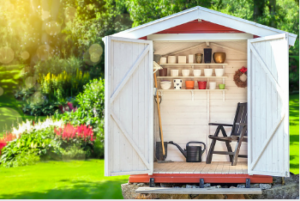A great site for installing a shed must feature a level surface free from rocks, stumps, trees or any other immovable objects; furthermore, it should be situated away from existing structures like retaining walls.
Local regulatory agencies frequently have regulations regarding how close a shed must be to your property line or other structures, increasing project costs significantly.
Location
 Location can have a substantial effect on the appearance of your shed. Many homeowners choose to conceal it from view; however, you could make your shed the focus of your property by placing it strategically. Well-designed custom sheds installation may even enhance curb appeal and increase resale value of homes in which they reside.
Location can have a substantial effect on the appearance of your shed. Many homeowners choose to conceal it from view; however, you could make your shed the focus of your property by placing it strategically. Well-designed custom sheds installation may even enhance curb appeal and increase resale value of homes in which they reside.
Consider local regulations and restrictions when selecting a location for your new shed. A permit may be needed, as well as setback requirements that you should know about. Contact your municipality’s building-code enforcement office for help and information.
Your build site must also be free from standing water, hills or valleys and moisture-rich environments such as damp basements. Such places can become damp and damp-prone over time, leading to wood rot, blistering paint and mildew build-up – which could compromise the longevity of your shed. A professional site preparation expert can help ensure a strong gravel pad or concrete foundation to support it while keeping wood rot at bay.
Removing immovable objects and leaving enough room for the shed delivery truck and trailer to access the area is wise at your build site. If necessary, ask permission from nearby neighbours so you can gain entry for the delivery of the shed. Once installed, hire a landscaper to reseed and fertilise the lawn or revamp the landscaping around it for optimal performance.
Materials
Framing lumber, plywood and shingles are among the many materials suitable for building sheds, with framing lumber being particularly versatile in its application. When selecting materials to construct sheds, quality should always come first – as the harsh winter climate can put undue strain on building structures that quickly wear down or damage low-grade materials.
Shed frames should be constructed of pressure-treated wood that can withstand heavy loads and weather conditions and should feature shelving or bins to store items efficiently and minimise clutter. Furthermore, organising your shed can save time and money in the long run; finding exactly what you’re searching for quickly will simplify locating items while protecting against rodents or other pests.
Windows and shutters add a unique flair to any shed and help regulate how much sunlight enters it. Windows are especially helpful for tool sheds as they keep equipment organised while protecting it from weather elements.
Before beginning construction on your shed, familiarise yourself with your community’s ordinances and building codes. Some municipalities require permits before building, while others might limit the materials used. If you doubt local requirements, contact an expert to ensure your shed meets all regulations.
Design
A shed can be ideal for storing gardening tools, shop equipment and much more. However, it’s essential that you remain aware of what should and shouldn’t be stored there; paint, paper products and other sensitive materials such as these should be stored elsewhere to avoid damage to them from pests or theft.
An efficient custom sheds installation design can save both time and money during its assembly. As part of your design process, consider factors like the necessary storage space, whether windows and doors are desired, and any special features like louvre gable vents. Also, check with your local building office to determine whether permits or other paperwork may be needed before starting this endeavour.
Before beginning to frame the walls of your shed, ensure you have a full-scale drawing. It will allow you to ensure wall studs are straight and the right materials are being used. If framing a gable end overhang, consider adding brackets – although additional work, these brackets look fantastic and add character.
Before your delivery day arrives, the site for your shed installation must be prepared accordingly. Check that no trees, branches, wires, fences, vehicles or narrow gates are present that could obstruct its construction or access. Furthermore, talk with neighbours to see if you require their permission before entering their property.
